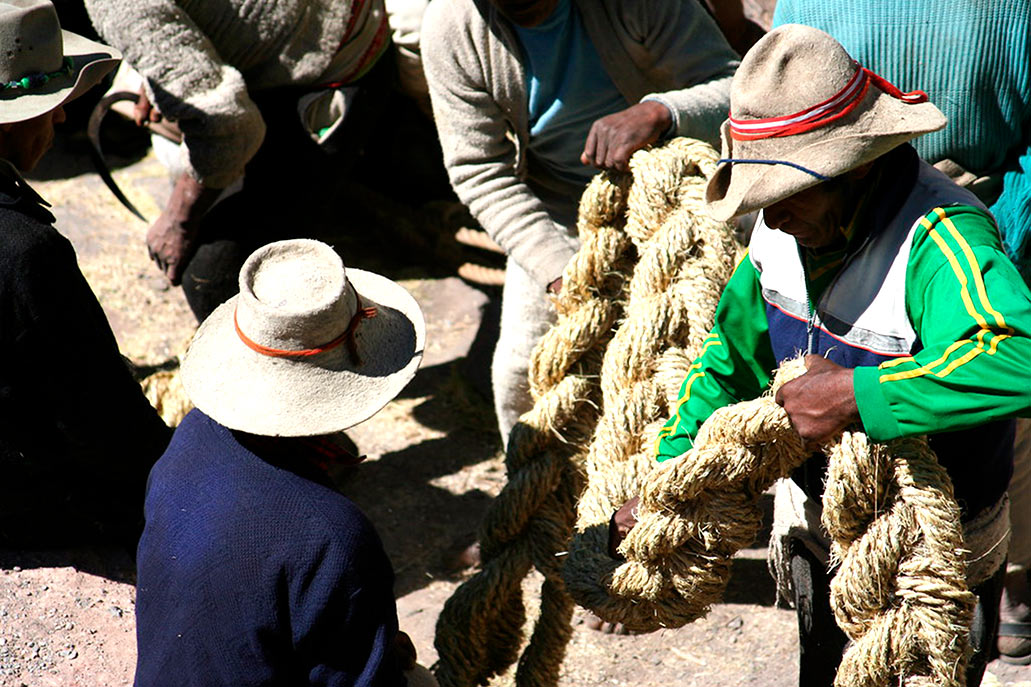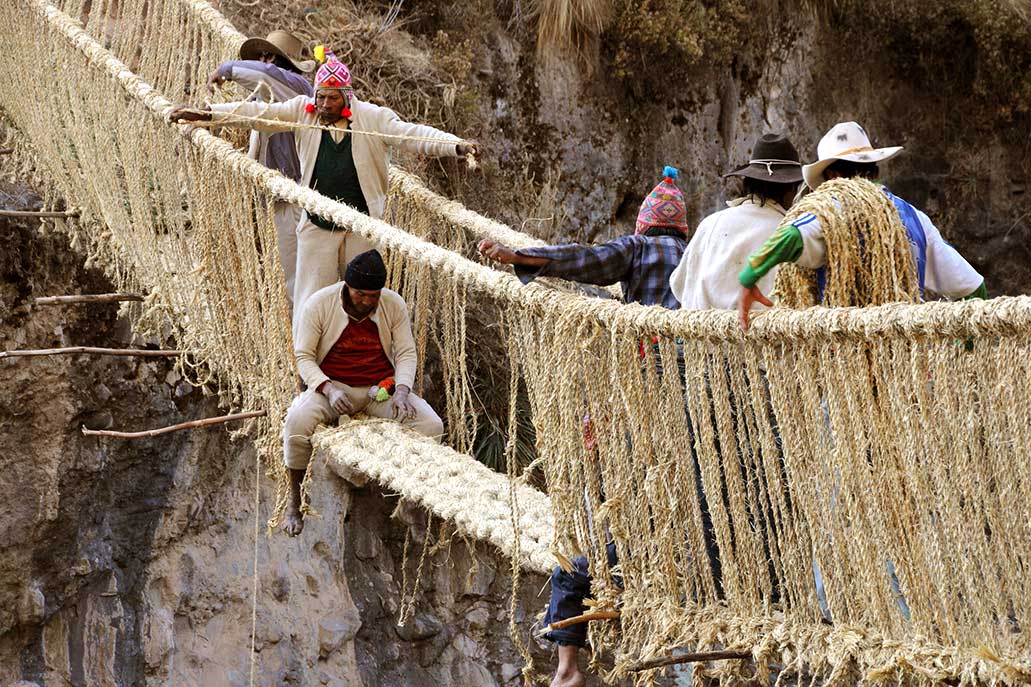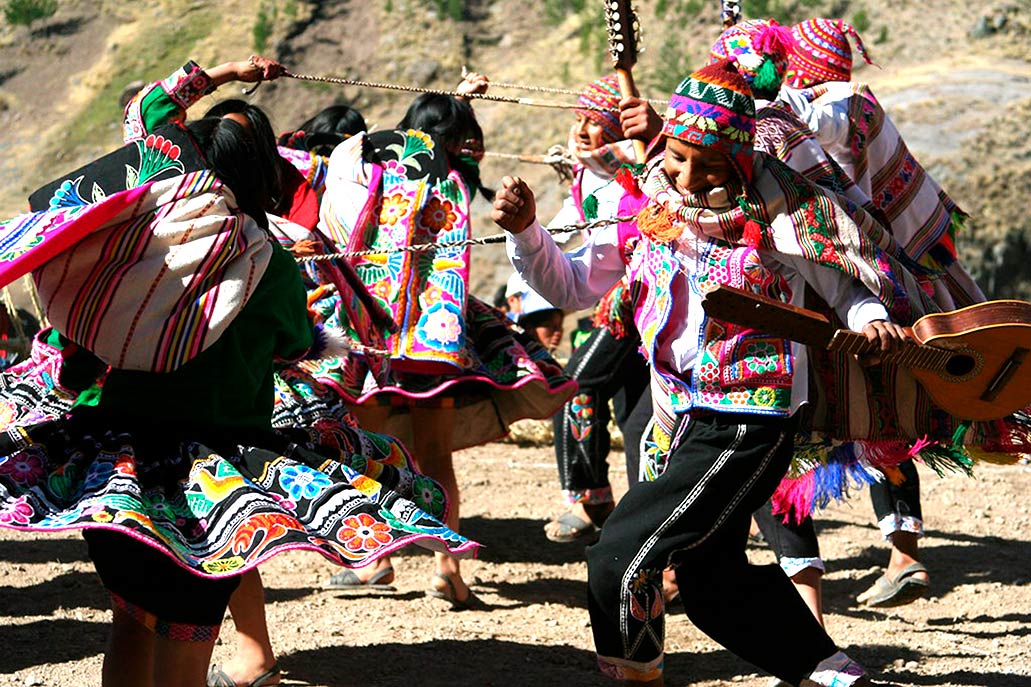Q’eswachaca, unmissable destination south of Cusco
Thanks to an ancient technique, not only a bridge is still preserved in the Qehue district, but also an entire tradition and cultural heritage. This bridge is approximately 600 years old. It served and still serves as a link between the surrounding communities. The residents of these communities meet every year to strengthen ties and, at the same time, revalue old eco-friendly forms of construction. Through the community work of 4 towns, this feat that crosses borders and draws the attention of the whole world is achieved.
Content
1. Like 600 years ago
The presence of the roads was necessary for any civilization that wants to expand its domains. The Inca empire was not oblivious to this need. It was necessary to build a network of roads that would cross the entire Andean mountain range until reaching the coast. In addition, this network of paths crosses different ecosystems, which are formed from the descent of the Andes Mountain Range until reaching the coast.
In this need it could be expected that the paths were not enough, so they devised the particular way of building bridges. The Q’eswachaca bridge is different from the rest, since the tradition that houses and maintains it cannot be easily seen in other places.
The Q’eswachaca bridge can be seen as it was 600 years ago, just as its first builders used it. Its construction is attributed to the Inca Pachacutec, who ruled during the years 1438 – 1471 AD, who is credited with consolidating the expansion of the Inca empire.
An important factor so that this temporary enclave can be preserved and transmitted. It was the vitality of transmitting knowledge through Oral tradition. This bridge is not only a vestige of the sophisticated road network of the Incas, but also an arduous task of leaving knowledge and accepting the cultural heritage. The communities responsible for weaving and placing this bridge are a perfect example of how oral transmission works.
The Qhapaq Ñan or Inca Trail, departed from Cusco to the main routes of the Tawantinsuyo or the 4 regions: Chinchaysuyo or “Land of the Jaguar”, Collasuyo or “Land of the Wise”, Contisuyo or “Land of the West”, Antisuyo or “Land of the Antis” (Antis or Campas, ancient ethnic group).
2. The Q’eswachaca Bridge
This bridge is the only one of the Inca bridges that was restored by different generations throughout six hundred years. The communities responsible for its elaboration and maintenance on an annual basis are: Huichiri, Ccollana, Chaupibanda and Choccayhua.
Both men and women are responsible for carrying out this important work. This task is carried out annually and everyone has a purpose in this journey that lasts 4 days. The men are in charge of carrying all the braided ropes that will replace them, while the women and children braid and pick up the Qoya-ichu again, which are the remains of the previous bridge that fell into the waters of the Apurimac River.
The Q’eswachaca bridge is located in the Qehue district, in the Cusco province of Canas. It is at an altitude of 3700 meters above sea level. For many it is considered a masterpiece of engineering and art due to the finish and the location where the famous bridge is located.
These vegetable fiber-based bridges were indispensable, as were stone constructions, thanks to their anti-seismic capabilities. In the case of the Q’eswachaca bridge, we find a construction based on fabrics or braids of ichu or straw. The bridge is 28 meters long and 1.20 meters wide.
On August 5, 2009 the National Institute of Culture of Peru declared the “Ritual of renovation of the Q’eswachaca bridge” as Cultural Heritage of the Nation and since December 4, 2013 it is considered Cultural Heritage of Humanity by UNESCO.
3. Four days for the renovation of the Inca bridge
At the end of May each year, the families of the four villages begin to weave around 50 armfuls of the rope that will be used for the bridge. With this work, the hereditary work and sequentiality are reaffirmed, plus the importance of oral transmission that allowed this activity to be transmitted for more than 500 years.
The women and children are in charge of braiding these long and resistant ropes that are initially 2 centimeters in diameter. However, although the work of women is recognized, they are kept aside at the time of construction because their presence is considered bad luck. It is a tradition that is still latent, we hope it will be put aside soon.
The weave starts from the outside in. The 4 main networks or ropes are joined with ropes and branches, even in some cases beef leather enters to give it more resistance and stability. Then the carpet is placed, which serves as a floor inside the bridge. After placing this “carpet” that is made from branches and leaves, the bridge is completed.
Everything mentioned is done over four days, we detail:
a) The first day:
- Something important that is done is the offering and gratitude to the Apus. In this ceremony the Apu Quinsallallawi is thanked. Likewise, after thanking him and leaving offerings, the Apu is asked to protect the communities and those who carry out said activity.
- After the ceremony, we proceed to collect the woven ropes that each family has to contribute. It is confirmed that each family contributes 40 meters.
- Then the ropes are laid out and weaving begins and the ropes are given more volume. Women do this work. While the men show up to do the cutting and some activities that require strength.
- This day the main ropes or major ropes are processed, which will serve as the base for the bridge. Also the ropes that will have less thickness to serve as railings. At sunset and to finish the day’s work, these ropes are left at both ends of the bridge.
b) Second day:
- Like the first day, you start by thanking and asking the Apu and Pachamama.
- After the greeting, the ropes begin to be transported from end to end along with other materials. When everything is ready for the construction of the new bridge, the nets of the previous bridge are cut.
- It begins with the weaving of the parts of the bridge that will be placed the next day. This activity is supervised by the chakaruwak, the railings and the knots must be placed perfectly. The ropes are also tied to the stones located at the beginning of the bridge. These stone structures are structures that serve as a support for the entire bridge.
- One of the communities is in charge of making the carpet, which is made from branches and leaves. Other similar fabrics are also used to keep the base more stable.
c) Third day:
- The third day begins by thanking the Apus and asking for their respective permission to begin with the weaving of the bridge.
- This work is done only by men. It starts from both ends from outside to inside. They culminate when they meet in the middle of the bridge. All the braids or ropes that were made the day before are placed.
- When the construction process is completed, the authorities are the first to cross the new bridge that extends approximately 30 meters above the riverbanks.
- The renovation of the Inca bridge is considered complete.
d) Fourth day:
- On the fourth day there is a ceremony, where all the residents of the communities gather and dance celebrating the culmination of this work that comes from ancient times. This party lasts all day.
The renovation of this bridge is the way to express to the world that these communities exist. Despite the passage of time, they continue to maintain their cultural traditions, alive. They continue to carry out these tasks and entrust this knowledge to the new generations.
In a way to encourage tourism to these places, different tours of one or two days were undertaken. Likewise, since 2015 the lodging service is introduced in the house of those responsible for the renovation of the bridge.
This is a must-do route for lovers of history and especially adventure.
4. Frequently asked questions
a) Where is the Q’eswachaca bridge?
The Q’eswachaca bridge, is located south of Cusco, in the province of Canas in the community of Qehue. Approximately 156 kilometers from Cusco.
b) What does Q’eswachaca mean?
It can be translated as “The woven bridge” or “braided bridge”.
c) What is the climate like at the Q’eswachaca bridge?
The bridge is close to the community of Qehue, so it has a cold temperate climate. As in most high Andean places. During the mornings it can reach temperatures close to 20 °C. or 68°F. While at night it can drop to 0 ° C. or 32°F.
d) How do you get to the bridge of Q’eswachaca?
There are two alternatives, the first is to go on your own and the second, which we will answer below, through a tourist tour.
To get to the Inca Q’eswachaca Bridge, take an interprovincial bus from Cusco to Combapata (2 hours). Then from Combapata a bus to the district of Yanaoca (30 minutes). Finally, a transport from Yanaoca to Qehue (50 minutes).e) When to go to Q’eswachaca?
You can go at any time of the year. The renovation of the bridge is carried out from the first week of June. The months in which it rains less or the dry season is from April to October.
f) Are you all there to go to Q’eswachaca?
Yes, most tours to the Q’eswachaca bridge last one day and cost around 40 to 50 US dollars, per person. This price varies according to the tourism company. There is also the possibility of going more days and staying with the families of the towns that carry out the renovation of the bridge.
g) How long is Q’eswachaca from Cusco?
Approximately 5 hours by bus. However, on the way you can enjoy other places, such as churches, lakes and restaurants.
By Imachupicchu – Last updated, August 22, 2024




